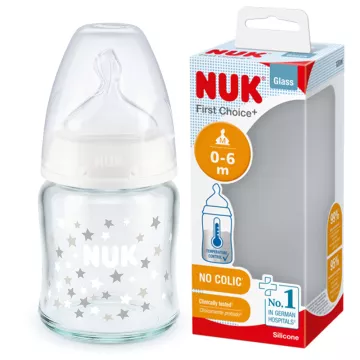Bottle-feeding is much more than a moment of nutrition: it's a moment of bonding, gentleness and trust. At Soin-et-nature, you'll find bottles carefully selected to meet the needs of toddlers from birth. Designed by well-known brands such as MAM, Nuk and Medela, they combine safety, ergonomics and practicality. Their carefully designed shapes ease the transition from breast to bottle, while guaranteeing comfortable sucking and optimal hygiene with every use.
More details


A healthy, full-term baby can generally adapt to any bottle. To make your choice, there are a number of features to consider: the size of the bottle, the type of nipple, the different flow rates on offer, ease of cleaning and price. No one model is preferable to another. So you can choose according to your preferences.
Bottle manufacturers also claim that their products have a number of advantages. For example, some bottles prevent the baby from swallowing air, thus reducing gas and bloating. Others are said to ease the transition from breast to bottle, reproducing as closely as possible the natural sucking sensation and reassuring the infant with a shape and texture close to the mother's breast.
There are a variety of teats on the market. Some differ in size, shape and flexibility. There's no single best choice, but there may be a teat that's better suited to your baby's sucking action. You may need to try a few models to find the one your baby prefers. If your baby tends to have more difficulty sucking, choose a softer teat. These nipples are designed to ease the transition from breastfeeding to bottle-feeding, while ensuring optimum comfort and impeccable hygiene.
For newborns, start with a slow-flow teat. It will be easier for him to learn to drink with a pacifier that flows more slowly. If the flow is too fast, your baby may choke or let milk escape from his mouth.
If you notice your baby making a lot of noise when he swallows, or if he tends to take big gulps, consider choosing a slower-flowing teat. As he grows, he'll appreciate a faster flow. The important thing is to follow his needs and rhythm.
Remember to check the condition of the teat regularly. If it has small tears, or if it changes appearance, it's a good idea to throw it away and use a new one. Generally speaking, we recommend replacing nipples every 2 or 3 months of use, according to the manufacturer's recommendations.
Feeding your baby is a privileged moment that allows you and your father to share in the sweetness and closeness of each other's company. The feeding bottle is an indispensable accessory for baby's meals.
All baby bottle models meet baby's needs, whether in terms of comfort during feeding,ease in the mouth or grip. You'll be perfectly equipped to make your baby's meals unforgettable, in complete serenity.
The size of the bottle should be adapted to your baby's age:
Small bottles are ideal for the first few weeks, especially for water or small quantities of breast milk.
An ergonomic bottle with an easy grip is ideal for parents and babies learning to hold their own bottles.
Some bottles have built-in anti-colic systems, designed to reduce air ingress during feeding. These systems can be particularly useful for babies with a tendency to bloat or reflux.
The nipple is an essential element, as it directly influences your baby's sucking action and comfort. Here are some points to consider:
Material
Shape
Flow
It's important to monitor your baby's feeding behaviour. If the milk flows too quickly or too slowly, adjust the flow rate of the teat accordingly.
To ensure optimum hygiene, clean feeding bottles immediately after each use, using a suitable brush. Sterilize them regularly, especially during your baby's first months of life.
Check the condition of nipples regularly, and replace them at the first signs of wear (cracks, deformation). In general, nipples should be changed every 2 to 3 months to avoid any risk of ingesting particles.
Feeding bottles available today are designed to meet the specific needs of babies and offer a pleasant experience for parents:
Soin-et-Nature offers a complete range of products dedicated to the feeding and comfort of toddlers, with an emphasis on safety and practicality. Here are the main sub-categories available:
These products, available at Soin-et-Nature, guarantee quality and safety for the well-being of toddlers and the peace of mind of parents.